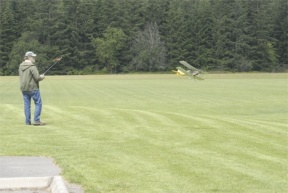LANGLEY — Wanted: fathers, grandfathers, sons and daughters and other would-be pilots.
While humans do not have wings, this has not stopped them from wanting to soar through the sky with their hair on fire. What mankind lacks in feathers, they make up for with problem-solving skills, having invented numerous methods for mechanized flying.
Still, not everyone can become a pilot of a full-scale aircraft, for a variety of reasons. That’s where model aviation allows the rest of us to fly while keeping our feet planted firmly on the ground — piloting an aircraft remotely with radio controls.
The words “Wright Brothers” might come to people’s minds when they think about early aviation, but an Englishman named Sir George Cayley is credited with inventing the first working model aircraft glider in 1804, and identifying the aerodynamic principles of weight, lift, drag and thrust.
Interest in flight has soared ever since.
Wild blue yonder
And now, Whidbey Island Radio Control Society is reaching out to the South Whidbey community to find those kids, their parents and even grandparents who would like to get a little wind under their wings.
“One of the club’s goals is to interest kids. It is all about opening the eyes of kids that they can do this sort of thing if they want to,” said club president Chuck Bower.
“We just have a good time and that is our interaction with the community; to enjoy and promote modeling. It is our love of seeing things fly. There is nothing better than building something and having it fly by.”
Anyone with even a minor interest in aviation may find something to enjoy in model aircraft.
Twenty people from the South End of the island comprise part of the 110-member club, Bower said, and club members fly large-scale turbine and ducted fan model aircraft at Naval Outlying Field Coupeville, gliders at the slopes of Fort Ebey and park fliers and other smaller aircraft types at the soccer fields of Community Park in Langley.
“There is something for everyone in model aviation, fortunately, finally,” he said.
An early take-off
Many club members said their love of flight began when they were young.
Retired Navy Adm. Bill Newman, a former Blue Angels commander who flew the Douglas A-4F Skyhawk II from 1978 to 1979, recently spoke about his Blue Angel experiences at a club meeting in Oak Harbor.
Newman fostered a love of aviation through modeling after seeing the Blue Angels perform for the first time as a child.
“There is definitely a connection between modeling and what
I did in the Navy,” he said.
“I went to a model meet when I was 13 years old and saw the Blue Angels fly. It was something that was indelible in my memory bank.”
Newman, a beginner in model aviation himself, sees tremendous value for kids who build, work on and fly their own model aircraft.
“I think the effort of constructing and then flying something, a model, on the part of a child is more meaningful than a video game on television,” he said.
“That is my take, based on my own childhood. I think there is so much creativity involved in modeling. And then, the satisfaction of seeing something you created actually perform is a big pump for a kid.”
Newman said there are similarities between operating radio-controlled planes and the jets he piloted as a Blue Angel.
“I think the degree of focus that is required to fly a radio controlled model remotely from the ground is the same kind of focus you need to fly a real airplane,” he said.
Building skills
Model aviation serves children in big picture ways as well, Bower said.
“Modeling helps with real world understanding of how things work. Video games can teach you a lot of things,” he said. “But when you have to put things together, to figure out how they work and do it with your hands, I think that the education side spreads out a lot further than just aviation. It is more exciting than just reading a book.”
Tom Berry, secretary and treasurer for the club, got his love of aviation during World War II as a child collecting aviation spotter cards from Kellogg’s PEP Cereal boxes.
“When we were kids, we had the Boy Scouts and a few other things like that. You had one or two different activities besides school,” he said. “But now, they have hundreds of things to do.”
Bower, who began with free-flight aircraft as a kid, now pilots incredibly-detailed high-performance aircraft at the Navy airstrip in Coupeville. He sees the trend in park flying — with battery-powered motors and their ability to fly in smaller flying fields — as a positive move for kids and a way to brings kids back into modeling.
“We have gotten away from being able to have kids see what we’re doing because of the kinds of airplanes we’ve been flying over the past 10 to 20 years at OLF Coupeville,” he said. “Now, we’re seeing park fliers. I think that we’re going to see that come back at more entry level because we go over to the soccer field and we fly, so we’re more visible by kids in the community.
“We are getting back to the time when we can go over to the soccer fields and do it safely. We are being accepted by the facilities because we are not impacting the place negatively,” he said.
Don’t forget that even Icarus could have used a few tips before his first flight. The club offers formal training at
OLF Coupeville starting at 6 p.m. on Tuesday nights during the summer months.
In addition to teaching people how to fly, the club hosts events, such as Jets Over Whidbey, which promotes high-tech model aviation at OLF Coupeville in August.
Contact Bower at cbrc@whidbey.com for more information about the club’s activities.



